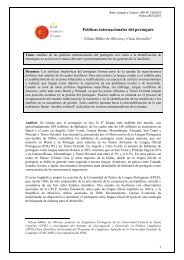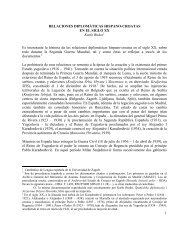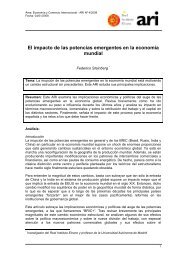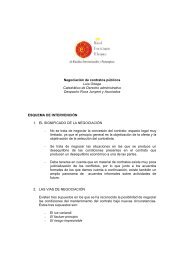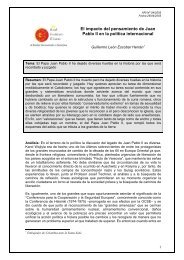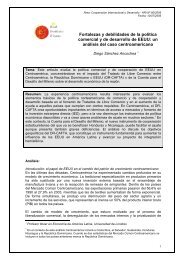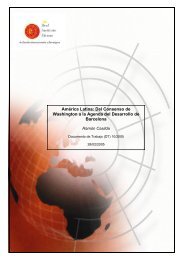Spain and the United States - Real Instituto Elcano
Spain and the United States - Real Instituto Elcano
Spain and the United States - Real Instituto Elcano
You also want an ePaper? Increase the reach of your titles
YUMPU automatically turns print PDFs into web optimized ePapers that Google loves.
94<br />
SPAIN AND THE UNITED STATES<br />
According to <strong>the</strong> 2000 census, <strong>the</strong> Hispanic population is very significant in<br />
some large metropolitan areas: 57% in Miami, 51% in San Antonio, 45% in<br />
Los Angeles <strong>and</strong> 25% in New York. Half of <strong>the</strong> 100 largest metropolitan areas<br />
in <strong>the</strong> <strong>United</strong> <strong>States</strong> have experienced explosive growth in <strong>the</strong>ir initially small<br />
Hispanic populations. For example, Atlanta’s Hispanic population rose from<br />
24,550 in <strong>the</strong> 1980 census (1% of <strong>the</strong> total) to 268,851 in <strong>the</strong> 2000 census (7%),<br />
a rise of 995%. Hispanics represent more than 14% of <strong>the</strong> total population, but<br />
close to 25% of <strong>the</strong> labour force because it is a much younger population. The<br />
median age of Hispanics is 26.9 years, compared with 35.3 years for <strong>the</strong><br />
broader US population <strong>and</strong> around 40 for non-Hispanic whites.<br />
Exhibit 5.3 Main US <strong>States</strong> with Hispanics (number <strong>and</strong> % of US total)*<br />
There are two drivers behind <strong>the</strong> surge in this population: (1) <strong>the</strong> large<br />
number of Hispanic immigrants who arrive in <strong>the</strong> <strong>United</strong> <strong>States</strong> every year; <strong>and</strong><br />
(2) Hispanics’ fertility rates, which are far higher than those of all o<strong>the</strong>r ethnic<br />
minorities (2.9 children per female versus 1.8 among white, non-Hispanics).<br />
Unlike o<strong>the</strong>r migrations, which came to an end (for example <strong>the</strong> European<br />
ones – Germans, Irish, English, Italians, French, Poles, Sc<strong>and</strong>inavians – from<br />
<strong>the</strong> 19 th century to <strong>the</strong> mid-20 th century), <strong>the</strong> one from Latin America,<br />
principally Mexico, is constantly evolving. The Hispanic community consists<br />
of people of many different national origins, united by a common language but<br />
by little else. Its members are also integrated into US society to varying<br />
degrees, depending on which generation <strong>the</strong>y belong to. The first generation is<br />
largely Spanish-speaking <strong>and</strong> economically <strong>the</strong> weakest; a substantial part of



